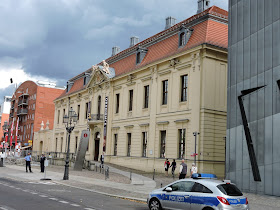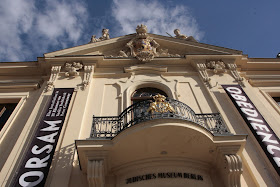Day 1
Day 2
Day 3
Weather - lovely (again)
Bit of a lazy start this morning, it is Saturday.
On our way.
I had mentioned that I had seen an amazing display on our first day in Berlin that showed Potsdamer Platz before during and after the Wall. That was my first introduction to The Wall and now have a better appreciation of its history.
The black line is the wall.
After World War II:
With the Wall:
Today it is a vibrant area with an energy that you can feel.
Once we are fortified we crossed over to the Wall Memorial.
A temporary exhibition on a new overall concept for Berlin Wall memorial sites has been put up by the Senate Department for Urban Development at Potsdamer Platz along the former course of the Berlin Wall. The exhibition is in two languages and describes both existing sites and future projects.
This is the first time that we have seen someone dressed as a soldier looking for people to pay for photos. Perhaps he was a day job.
Not much of a mission today just planning on a couple of things.
This building catches john's eye.
In the general direction of the Brandenburg Gate.
Fall is in the air.
Tiergarten in Berlin refers to the parliamentary, government and diplomatic district as well as to Berlin’s largest and most popular inner-city park. The Tiergarten (animal park) and former hunting ground is Berlin’s best known park because of its centrality.
We head to Brandenburg Gate and it is packed with tour buses so we just take a couple more photos and then stroll down the street towards Victoria.
The memorial is located in the Großer Tiergarten, a large public park to the west of the city centre, on the north side of the east-west Straße des 17. Juni (17 June Street) in the Tiergarten locality.
It is huge, look at John!
n 1953, West Berlin renamed the street Straße des 17. Juni, to commemorate the uprising of the East Berliner workers on 17 June 1953, when the Red Army and GDR Volkspolizei shot protesting workers.
The Victory Column is a monument to commemorate the Prussian victory in the Danish-Prussian War, by the time it was inaugurated on 2 September 1873, Prussia had also defeated Austria in the Austro-Prussian War (1866) and France in the Franco-Prussian War (1870–71), giving the statue a new purpose. Different from the original plans, these later victories in the so-called unification wars inspired the addition of the bronze sculpture of Victoria, 8.3 metres high and weighing 35 tonnes, designed by Friedrich Drake. Berliners have given the statue the nickname Goldelse, meaning something like "Golden Lizzy".
The Victory Column is a major tourist attraction in the city of Berlin. Its viewing platform offers a view over Berlin with paid entry.
Back into the peace and quiet of the Tiergarten.
The Beethoven-Haydn-Mozart Memorial (German: Komponistendenkmal) is an outdoor 1904 memorial to the classical composers Ludwig van Beethoven, Joseph Haydn and Wolfgang Amadeus Mozart,
Across the street and back in front of the Gate.
Our first planned stop, the Holocaust Memorial we had missed on our first day. Click on the photo for a better view.
The Memorial to the Murdered Jews of Europe, also known as the Holocaust Memorial is a memorial in Berlin to the Jewish victims of the Holocaust, designed by architect Peter Eisenman and engineer Buro Happold. It consists of a 19,000 m2 (4.7-acre) site covered with 2,711 concrete slabs or "stelae", arranged in a grid pattern on a sloping field. The stelae are 2.38 m (7 ft 10 in) long, 0.95 m (3 ft 1 in) wide and vary in height from 0.2 to 4.8 m (7.9 in to 15 ft 9.0 in). They are organized in rows, 54 of them going north–south, and 87 heading east–west at right angles but set slightly askew.
A temporary exhibition on a new overall concept for Berlin Wall memorial sites has been put up by the Senate Department for Urban Development at Potsdamer Platz along the former course of the Berlin Wall. The exhibition is in two languages and describes both existing sites and future projects.
This is the first time that we have seen someone dressed as a soldier looking for people to pay for photos. Perhaps he was a day job.
Not much of a mission today just planning on a couple of things.
This building catches john's eye.
Head into Tiergarten, we had been here on our first day but hadn't ventured too far inside.
LOOK AT ALL THOSE BUSES!
Walking away from the maddening hordes we find this memorial.
The Soviet War Memorial (Tiergarten) is one of several war memorials in Berlin, erected by the Soviet Union to commemorate its war dead, particularly the 80,000 soldiers of the Soviet Armed Forces who died during the Battle of Berlin in April and May 1945.
The memorial is located in the Großer Tiergarten, a large public park to the west of the city centre, on the north side of the east-west Straße des 17. Juni (17 June Street) in the Tiergarten locality.
It is huge, look at John!
We exit onto 17 June Street, it is the western continuation of the Unter den Linden. It runs east-west through the Tiergarten. At the eastern end of the street is the Brandenburg Gate, it then passes the Soviet War Memorial before passing either side of Victory Column (Siegessäule) in the middle of the park.
The Victory Column is a monument to commemorate the Prussian victory in the Danish-Prussian War, by the time it was inaugurated on 2 September 1873, Prussia had also defeated Austria in the Austro-Prussian War (1866) and France in the Franco-Prussian War (1870–71), giving the statue a new purpose. Different from the original plans, these later victories in the so-called unification wars inspired the addition of the bronze sculpture of Victoria, 8.3 metres high and weighing 35 tonnes, designed by Friedrich Drake. Berliners have given the statue the nickname Goldelse, meaning something like "Golden Lizzy".
The Victory Column is a major tourist attraction in the city of Berlin. Its viewing platform offers a view over Berlin with paid entry.
In the middle of the street.
What it looked like with the wall. On August 14, 1961, one day after the construction of the Berlin Wall, the Brandenburg Gate closed. Pariser Platz was now a desolate wasteland and the gate became to symbolize the division of Berlin and Germany.
The Beethoven-Haydn-Mozart Memorial (German: Komponistendenkmal) is an outdoor 1904 memorial to the classical composers Ludwig van Beethoven, Joseph Haydn and Wolfgang Amadeus Mozart,
Our first planned stop, the Holocaust Memorial we had missed on our first day. Click on the photo for a better view.
The Memorial to the Murdered Jews of Europe, also known as the Holocaust Memorial is a memorial in Berlin to the Jewish victims of the Holocaust, designed by architect Peter Eisenman and engineer Buro Happold. It consists of a 19,000 m2 (4.7-acre) site covered with 2,711 concrete slabs or "stelae", arranged in a grid pattern on a sloping field. The stelae are 2.38 m (7 ft 10 in) long, 0.95 m (3 ft 1 in) wide and vary in height from 0.2 to 4.8 m (7.9 in to 15 ft 9.0 in). They are organized in rows, 54 of them going north–south, and 87 heading east–west at right angles but set slightly askew.
Time to rest these weary bones with a beer.
Next stop the Jewish Museum.
On Niederkirchner Straße we found this sculpture of two people peering through a wall directly across the street from parts of the wall.
We had seen the trabant tours go by everyday and found its home.
The Trabant /trəˈbɑːnt/ is a car that was produced by former East German auto maker VEB Sachsenring Automobilwerke Zwickau in Zwickau, Saxony. It was the most common vehicle in East Germany, and was also exported to countries both inside and outside the Eastern Bloc. It was advertised as having room for four adults and luggage in a compact and durable shell; and being relatively fast.
The Jewish Museum Berlin (Jüdisches Museum Berlin) is one of the largest Jewish Museums in Europe. In three buildings, two of which are new additions specifically built for the museum by architect Daniel Libeskind, two millennia of German-Jewish history are on display in the permanent exhibition as well as in various changing exhibitions.
Don't expect this to be a Holocaust Museum like the one in Washington DC that we visited last year.
Or the Holocaust Museum in Budapest.
This museum is dedicated to all things Jewish.
Information from the museum's website.
Unlike in most museums, the way to the permanent exhibition at the Jewish Museum Berlin is downstairs.
The connection between the Baroque building through which one enters the museum and the new building designed by Daniel Libeskind which houses the exhibitions is underground. Dark and winding are the stairs that symbolically link the past, present, and future of German-Jewish coexistence.
These Christmas trees had no religious significance, but were a sign of a cultural rapprochement. Christmas was celebrated as a German family event – it was a national happening and many Jews did not want to miss being part of it.
And then this rather odd guy who wouldn't entice me into his place for a hot dog.
A monument to former Soviet President Mikhail Gorbachev, former U.S. President George Bush Senior and former German Chancellor Helmut Kohl placed on meter-high plinths in front of the headquarters of Axel Springer publishing house.
Another reminder of the Wall.
wiener schnitzel.
On the way back we notice this building with all these cute little people.
Distance covered - 20385 steps or 15.5 km 8.6 miles













































































